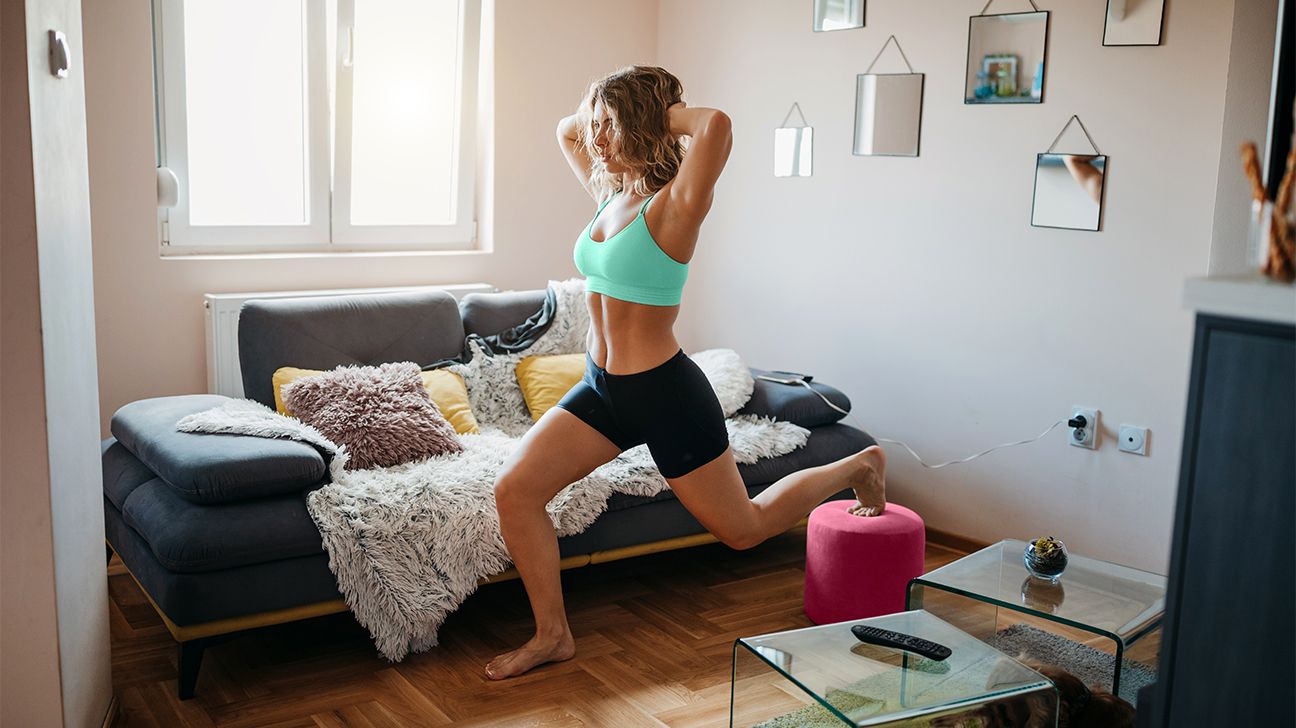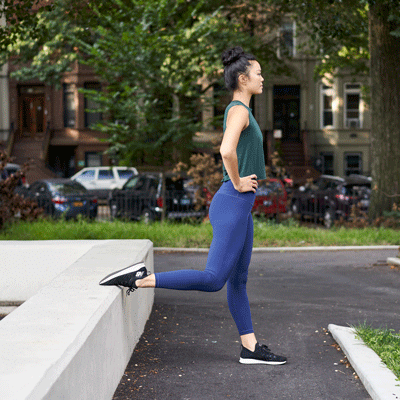Sure! Could you please provide the introductory lines of the article?
If you’re shooting for firmer glutes and better balance, squats are a dope option. But(t) to really turbocharge that booty, you might have a blast with the Bulgarian split squat.
Here’s how to pull off this challenging squat, plus alternative workouts and variations for similar results.

Bulgarian split squats are an intermediate-level exercise that helps strengthen your lower bod while increasing stability and balance.

Here’s how to do a Bulgarian split squat:
- Stand a couple of feet in front of a flat surface like a park bench, workout bench, or small platform. Your feet should be shoulder-width apart.
- Put the top of your right foot flat against the surface behind you.
- Get into a forward lunge position and engage your core. Keep torso upright and hips square to your body.
- Bend your left knee and drop into a squat.
- Return to the starting position by pushing up through your left foot, using your quads and hamstrings.
- Repeat for 2 sets of 6–8 reps on each leg.
Pro tip: If you’re focusing on your quads, don’t let your left knee reach beyond your toes. If you’re focusing on your glutes, keep squatting down until your left thigh is almost horizontal.
The Bulgarian split squat is a butt-busting workout that targets your:
- glutes
- quads
- calves
- hip flexors
- hamstrings
- spinal erectors
In addition to strengthening your lower bod, Bulgarian split squats can enhance coordination and balance.
According to a small 2017 study, they’re also great for evening out strength differences between one leg and the other. This is beneficial for anyone who spends a lot of time on their feet.
Depending on your current level of expertise, you might want to tweak the Bulgarian split squat. Here are five fab variations to help you customize your workouts.
1. Standard split squat
Easier than its Bulgarian cousin, a standard split squat merely calls for one leg to be extended behind you. You’re basically squatting from a lunge position.
This is a good exercise to try if you’re bored with regular squats but can’t quite nail the balance when your back leg is elevated.
2. Weighted Bulgarian split squat
If you feel you’ve mastered the Bulgarian split squat, adding weights can amp up the resistance and net you some additional booty gains. Whether you use a barbell across your shoulders or hold dumbbells at your sides, this is an effective way to step up the move.
Take it slow — don’t go for your personal powerlifting record at first. You’ll be surprised how much more challenging the move becomes with only a little weight.
3. Zercher Bulgarian split squat
In a Zercher Bulgarian split squat, you hold a loaded barbell against your chest as you perform the move. This adds extra core activation to the squat. Your upper back and quads come into play as you balance between the leg behind you and the weight in front.
4. Exercise ball Bulgarian split squat
Proper leg spacing and balance are key to getting the Bulgarian split squat right. So, if you’re really trying to up the difficulty, make it harder to find that balance.
Resting your back leg on an exercise ball as you squat makes it harder to use that leg for stability. The added balance and stability you get from your suspended back leg during a Bulgarian split squat is significant.
5. Eccentric Bulgarian split squat
In this hella-hard variant, you lower down as slowly as you can for maximum activation. This increases the tension on your legs and makes you focus on perfect form. Once you’ve got it down, the results should speak for themselves.
Bulgarian split squats are generally considered safe for intermediate fitness enthusiasts. But you might want to try an easier variation if you’re brand-new to working out. This exercise requires a decent amount of coordination, lower-body strength, and balance.
Here are a few tips to help you do this exercise safely:
- Warm up. Give your lower half a solid stretch before you jump into these squats.
- Maintain proper form. Poor form can make the workout less effective and increase your risk of injury.
- Find your footing. Take your time positioning your feet. Remember, this squat is all about proper alignment and balance.
- Be kind to your knees. You might want to avoid Bulgarian split squats if you have a history of knee concerns. Deep squats can be hard on your joints.
- Don’t push past your limits. These squats can be pretty tough, especially if you’re a beginner. So be sure to start slowly and work your way up to more reps and sets.
Whether you want to keep your workouts fresh and fun or you just don’t vibe with Bulgarian split squats, there are lots of alternative moves that offer similar results. Here are five you can try at home or in the gym.
1. Classic squat
If you’re building up to a more advanced move, there’s no shame in going back to basics.
To do a classic squat:
- Stand with feet shoulder-width apart.
- Angle feet outward about 10 degrees. Your heels should remain planted into the floor. Keep your spine neutral, shoulders back, and chest open.
- Lower down into the squat by leading with your hips, like you’re about to sit down in a chair.
- Bend as far as you can while keeping a neutral spine. Try to get your thighs parallel to the floor.
- Press through your heels to rise back up to the starting position.
- Repeat.
P.S. You can clasp your hands in front of you with your elbows slightly bent, reach your arms out straight in front of you, or place your hands on your hips.
2. Pistol squat
This one-legged squat works on balance, mobility, and strength.
To do a pistol squat:
- Stand with feet together and arms out in front of you.
- Lift left leg and keep it straight as you lower into the squat on your right leg.
- Lower until your left leg is parallel to the floor.
- Drive through your right heel to return to the starting position, then repeat on the other leg.
FYI: You can up the intensity by adding a dumbbell to your pistol squats.
3. Sidekick squat
Throwing a kick into a squat gets your heart pumping faster while strengthening your lower bod.
To do a sidekick squat:
- Drop into a standard squat.
- Drive with your heels to come back up.
- As you reach the standing position, kick your right leg out to the side as far as you can.
- Make sure your kicking leg returns to the proper position for your next squat.
- Repeat and kick with the other leg.
4. Curtsy squat
Have you ever been mid-workout and the Queen of England walks into the gym? Well, we have the perfect workout for you! The curtsy squat gives your glutes an extra workout in addition to being polite to Her Majesty.
To do a curtsy squat:
- Stand with feet shoulder-width apart and place hands on your hips.
- Squat with your left leg while stepping your right leg back, crossing it behind your left.
- Lower until left leg is parallel to the floor.
- Push through left heel to return to the starting position.
- Repeat on the other side.
5. Jump squat
A jump squat tests your coordination and the explosive strength in your legs.
To do a jump squat:
- Stand with feet shoulder-width apart.
- Angle your feet outward about 10 degrees. Your heels should remain planted into the floor. Keep your spine neutral, shoulders back, and chest open.
- Lower down into the squat by leading with your hips, like you’re about to sit down in a chair.
- Jump up, straightening your legs.
- Land softly with your feet back in the starting position.
- Repeat.
Bulgarian split squats and classic squats are great strength builders for your lower body. They target similar muscles slightly differently.
Research suggests that regular squats are good at working your muscles as they contract (agonists) and the Bulgarian split squat targets muscles as they relax (antagonists).
In particular, the Bulgarian version focuses on some of the hamstring muscles right below your butt (aka the biceps femoris). These are sometimes tougher to activate. For this reason, it might be a good idea to include both types of squats in your workout routine.
The Bulgarian split squat is a great workout for your lower body. It can also help increase stamina, strength, stability, and balance. Just keep in mind that this move is not for everyone. You might not want to do these squats if you have a history of knee problems or if you’re new to working out.
If Bulgarian split squats aren’t your thing, you can opt for another type of squat or lower body workout. You can also try a Bulgarian squat variation for an easier exercise or tougher challenge.

